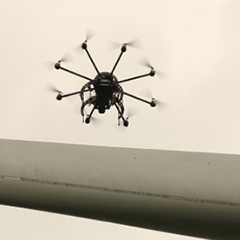Morgan Troedsson, Product Manager for FORCE Technology, writes exclusively on the topic of blade maintenance offshore, and offers an expert industry perspective, coupled with an organisational overview.
FORCE Technology is a leading technological consulting and service provider internationally. Our target is to sell highly specialised engineering know-how that delivers useful and efficient testing solutions to the wind energy industry.
The solutions we provide enhance customer competitiveness and are based on both customer and industrial insight, that we have acquired over 25 years in wind energy. That alone makes FORCE Technology the market leader in integrated systems for automated quality inspection on rotor blades.
We have more than 1,200 employees, located at the headquarters in Broendby and with subsidiary companies and multiple local offices in Sweden, Norway, Russia, China, Singapore and the USA.
Offshore turbines
Wind turbines erected offshore were initially not designed for the offshore environment. Tough lessons were learnt from the early installations – e.g. in the Nordic Sea – and anything that could fail, did. The external ladders and access platforms on turbine towers were basically flushed away, as heavy waves hit and climbed along the tower base.
The environmental impact on the whole turbine structure was much higher than expected. Gearbox failures were common. Heat dissipation, electronics cooling, as well as nacelle venting, was not as easy as expected. The internal cooling system was in most cases not functional. Corrosion effects inside the nacelle and on foundations became visible, and required specific designs for offshore wind turbines.
Rotor blades were subjected to heavy and unexpected environmental load. Surface gel coatings were basically not sufficiently resistant to the harsh offshore conditions. Leading edges of rotor blades started to erode much earlier than expected. The erosion rate was quite high. Lessons learnt were that offshore rotor blades require professional refurbishment after only three to five years in continuous operation. Onshore blade refurbishment is normally done after eight to twelve years.
“Offshore, failure is not an option”
Condition testing
It came as an unexpected surprise to anyone in wind power business that offshore wind turbine blades degraded so early in their life. Wind fatigue load is quite substantial offshore, causing premature damages and cracks to the blade structure itself. Even more obvious is the damaged aerodynamic appearance, with worn coatings and leading edges seriously eroded after only four years in average.
Leading utility power producers as well as Independent Power Producers (IPP) today realise that they have to protect and preserve their production assets properly. A maintenance strategy may prescribe proper condition testing on critical components (e.g. blades) at regular intervals. After commissioning approval, turbines are maintained properly through a service contract, often signed with the OEM service department.
Prior to expiration of the contracted warranty period all installed blades should be reviewed at least visually by an independent inspection service provider. Further on, any rotor blades installed and operating offshore should be subjected to a recurring complete inspection every four years (± one year) during their remaining life cycle. This is the main procedure assuring that the specified blade performance is kept. Aerodynamic efficiency and yield is maintained at the expected level. Catastrophic failures and costly repairs may as well be avoided during the windy productive seasons in special.



























